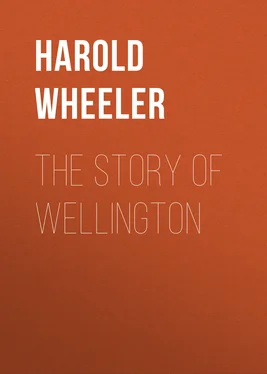Harold Wheeler - The Story of Wellington
Здесь есть возможность читать онлайн «Harold Wheeler - The Story of Wellington» — ознакомительный отрывок электронной книги совершенно бесплатно, а после прочтения отрывка купить полную версию. В некоторых случаях можно слушать аудио, скачать через торрент в формате fb2 и присутствует краткое содержание. Жанр: foreign_prose, История, foreign_edu, foreign_antique, на английском языке. Описание произведения, (предисловие) а так же отзывы посетителей доступны на портале библиотеки ЛибКат.
- Название:The Story of Wellington
- Автор:
- Жанр:
- Год:неизвестен
- ISBN:нет данных
- Рейтинг книги:3 / 5. Голосов: 1
-
Избранное:Добавить в избранное
- Отзывы:
-
Ваша оценка:
- 60
- 1
- 2
- 3
- 4
- 5
The Story of Wellington: краткое содержание, описание и аннотация
Предлагаем к чтению аннотацию, описание, краткое содержание или предисловие (зависит от того, что написал сам автор книги «The Story of Wellington»). Если вы не нашли необходимую информацию о книге — напишите в комментариях, мы постараемся отыскать её.
The Story of Wellington — читать онлайн ознакомительный отрывок
Ниже представлен текст книги, разбитый по страницам. Система сохранения места последней прочитанной страницы, позволяет с удобством читать онлайн бесплатно книгу «The Story of Wellington», без необходимости каждый раз заново искать на чём Вы остановились. Поставьте закладку, и сможете в любой момент перейти на страницу, на которой закончили чтение.
Интервал:
Закладка:
On the 23rd September the General found himself and his small contingent of some 8000 soldiers face to face with the whole combined army of Sindhia and the Rájá of Berar, a state of affairs brought about by unreliable information, causing the separation of Wellesley and Stevenson. At least 50,000 of the enemy were posted in a strong position behind the river Kaitna, near the village of Assaye. As Wellesley had received no reinforcements, and had only 17 guns compared with 128 commanded by skilful French officers at the disposal of the Marhattás, the disproportion of the forces was sufficiently obvious. To a general less experienced or daring the situation would have been considered sufficient cause for an instant retreat; even he called the attack “desperate.” The problem for him to settle was, should he wait a few hours for Stevenson, or begin immediately with the scanty resources at his disposal? Although only 1500 of his men were British, the Commander-in-Chief decided on the latter alternative, ignoring the information vouchsafed by his guides that the river was absolutely impassable. Yet it was only by crossing the stream that he could take advantage of the opportunity to attack. Here Wellesley’s native wit and acute intelligence—he himself called it “common sense”—assisted him. His telescope merely revealed a village on either side of the stream. This fact suggested the probability of a neighbouring ford. On investigation such proved to be the case, and if the passage was difficult the General was at least fortunate in being able to carry out the operation without severe molestation by the enemy, who had foolishly neglected to guard this point. They repaired the omission so far as was possible by firing upon the oncoming army as it slowly waded across, but the losses were comparatively trivial. “All the business of war,” Wellesley once told Croker, “and indeed all the business of life, is to endeavour to find out what you don’t know by what you do.”
The battle began well by the routing of some of the infantry and artillery by the Highlanders and Sepoys. This advantage was almost immediately counterbalanced by the mistaken zeal of the officer commanding the pickets, supported by the 74th Regiment. He foolishly led his men against the village, thereby exposing them to the concentrated fire of the enemy’s artillery and musketry stationed there. Had he taken a less direct route, this could not have happened, but his enthusiasm overruled his caution. Men dropped down like ninepins in a skittle-alley when the ball is thrown by a skilful player. They fell by the dozen as they came within the zone of fire. Their comrades filled up the tell-tale gaps and continued to push on with a dogged tenacity entirely worthy their intrepid commander. Meanwhile what few British guns remained pounded away, and were silenced one by one as the men who worked them fell dead at their post. The enemy’s cavalry then proceeded to decimate the already sorely depleted ranks of the 74th.
At this moment the 19th Light Dragoons, under Colonel Maxwell, were hurled at Sindhia’s troops. The charge turned the fate of the day. What remained of the 74th rallied under the support thus given, and when Wellesley led the 78th into action the village fell. An attempt was made by the enemy to rally, but it was too late. Men who, with true Oriental cunning, had fallen as though killed in order to avoid the oncoming British cavalry as they charged, and had escaped the iron-shod hoofs of the horses, rejoined the ranks, only to find that the day had been lost. The whole body was soon flying helter-skelter from the blood-stained field towards Burrampur, abandoning artillery, baggage, ammunition—everything that precluded swift movement. Twelve hundred of the Marhattás breathed their last on this memorable day.
In fighting this battle—“the hardest-fought affair that ever took place in India”—o’er again in the twilight of his days, the Duke of Wellington made light of the indiscretions of the officers at Assaye and remembered only their bravery. “I lost an enormous number of men: 170 officers were killed and wounded, and upwards of 2000 non-commissioned officers and privates; 16 16 79 officers and 1778 soldiers were killed and wounded.—Sir Herbert Maxwell, p. 58.
but we carried all before us. We took their guns, which were in the first line, and were fired upon by the gunners afterwards, who threw themselves down, pretending to be dead, and then rose up again after our men had passed; but they paid dearly for the freak. The 19th cut them to pieces. Sindhia’s infantry behaved admirably. They were in support of his cannon, and we drove them off at the point of the bayonet. We pursued them as long as daylight lasted and the exhausted state of the men and horses would allow; and slept on the field.” 17 17 Gleig, pp. 37–8.
Wellesley himself, although not wounded, lost two horses. An eye-witness has recorded that he had never seen “a man so cool and collected as he was the whole time.” Stevenson arrived on the following evening, and set out almost immediately to follow the enemy, Wellesley being forced to remain owing to his lack of transport for the wounded, whom he refused to leave. The Colonel seconded Wellesley’s magnificent victory by reducing the fortress of Burrampur on the 16th October, and that of Asseerghur on the 21st. Wellesley covered Stevenson’s operations and defended the territories of the Nizám and the Peshwá. “I have been like a man who fights with one hand and defends himself with the other,” he notes on the 26th October. “I have made some terrible marches, but I have been remarkably fortunate: first, in stopping the enemy when they intended to press to the southward, through the Casserbarry ghaut; and afterwards, by a rapid march to the northward, in stopping Sindhia, when he was moving to interrupt Colonel Stevenson’s operations against Asseerghur; in which he would otherwise have undoubtedly succeeded.”
CHAPTER V
Last Years in India
(1803–5)
“ Time is everything in military operations. ”
Wellington.Bhonsla Rájá now became the immediate object of Wellesley’s attention. While proceeding in quest of him the General received envoys from Sindhia requesting an armistice. This was granted on the 23rd November 1803, the principal condition imposed by Wellesley being that the enemy’s army should retire forty miles east of Ellichpúr. This clause was not fulfilled, the cavalry of the wily Sindhia encamping at Sersooly, some four miles from the position occupied by Manoo Bappoo, brother of the Rájá, ready for immediate co-operation. Having again united their divisions, Wellesley and Stevenson pushed towards them. “A confused mass” about two miles beyond Sersooly proved to be the enemy’s armies on the march. A little later the General made out “a long line of infantry, cavalry, and artillery, regularly drawn up on the plains of Argaum, immediately in front of that village.”
“Although late in the day,” says Wellesley in describing the events of the 29th November, “I immediately determined to attack this army. Accordingly, I marched on in one column, the British cavalry leading in a direction nearly parallel to that of the enemy’s line; covering the rear and left by the Mogul and Mysore cavalry. The enemy’s infantry and guns were in the left of their centre, with a body of cavalry on their left. Sindhia’s army, consisting of one very heavy body of cavalry, was on the right, having upon its right a body of pindarries and other light corps. Their line extended above five miles, having in their rear the village and extensive gardens and enclosure of Argaum; and in their front a plain, which, however, was much cut by watercourses, etc.
Читать дальшеИнтервал:
Закладка:
Похожие книги на «The Story of Wellington»
Представляем Вашему вниманию похожие книги на «The Story of Wellington» списком для выбора. Мы отобрали схожую по названию и смыслу литературу в надежде предоставить читателям больше вариантов отыскать новые, интересные, ещё непрочитанные произведения.
Обсуждение, отзывы о книге «The Story of Wellington» и просто собственные мнения читателей. Оставьте ваши комментарии, напишите, что Вы думаете о произведении, его смысле или главных героях. Укажите что конкретно понравилось, а что нет, и почему Вы так считаете.












